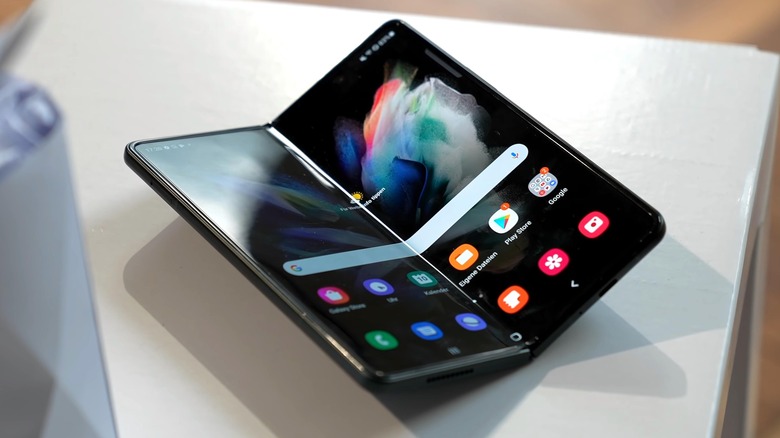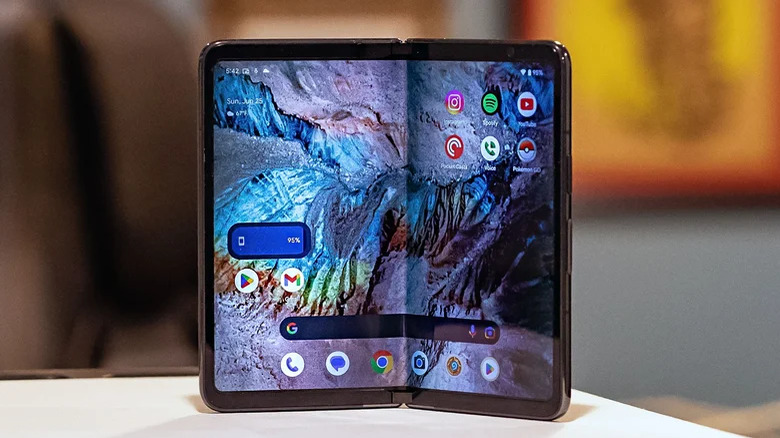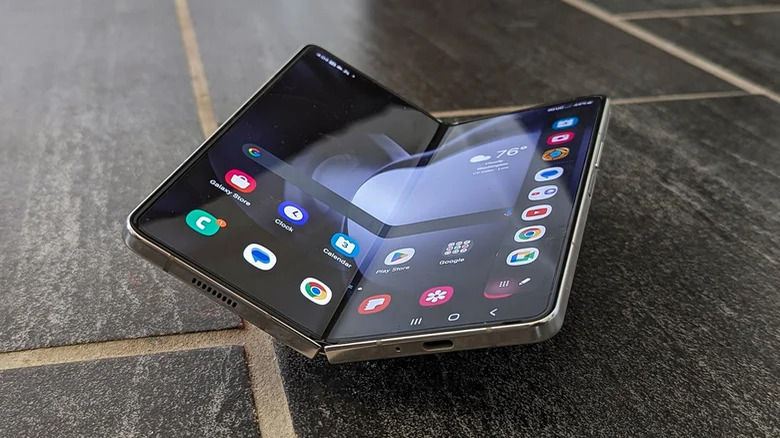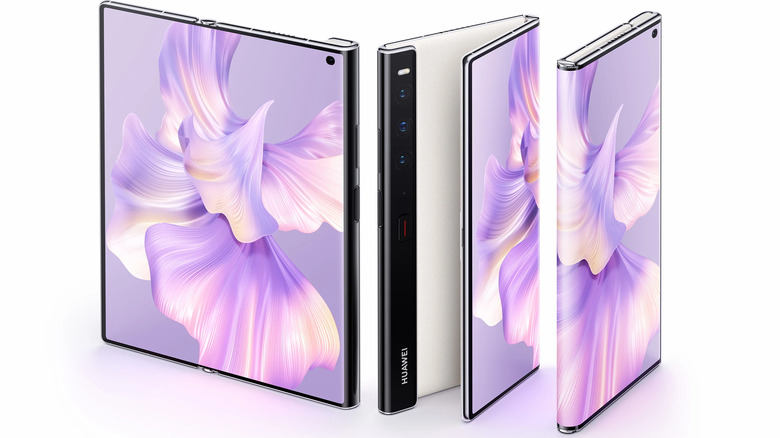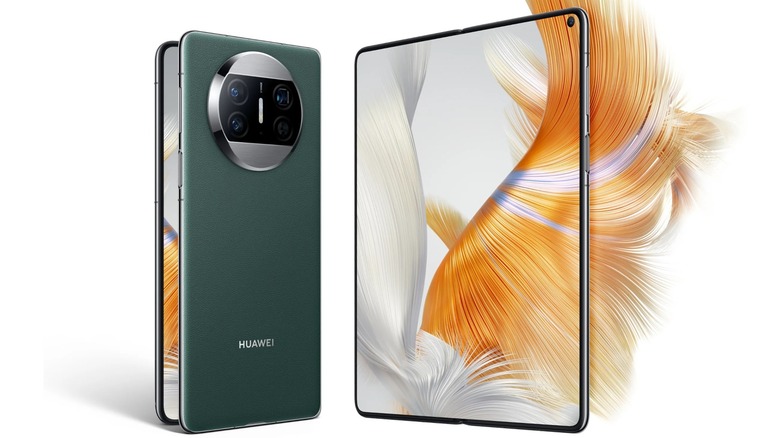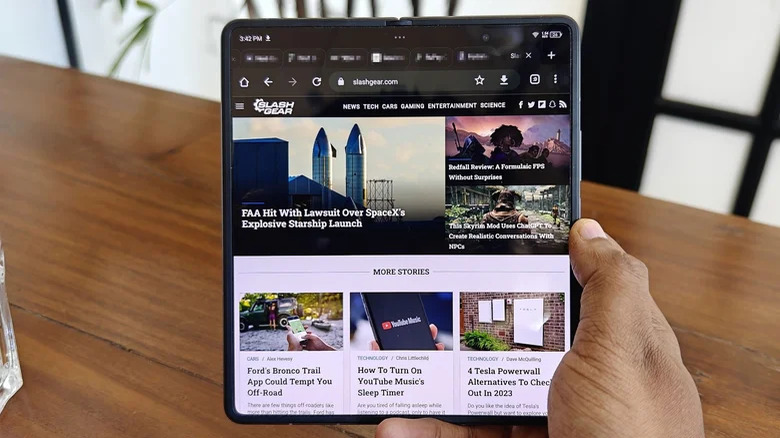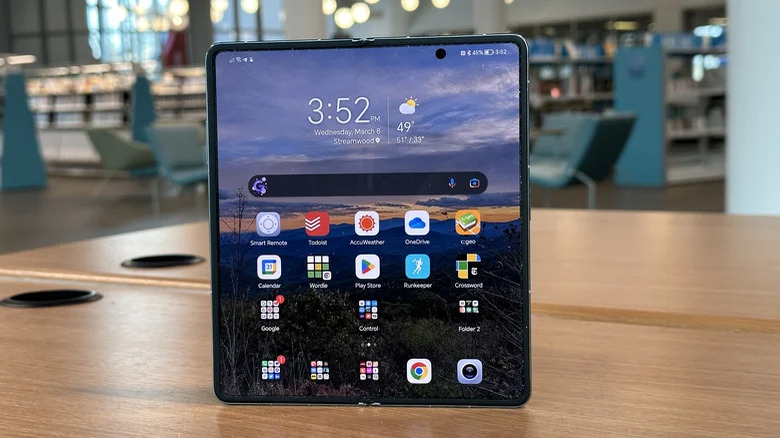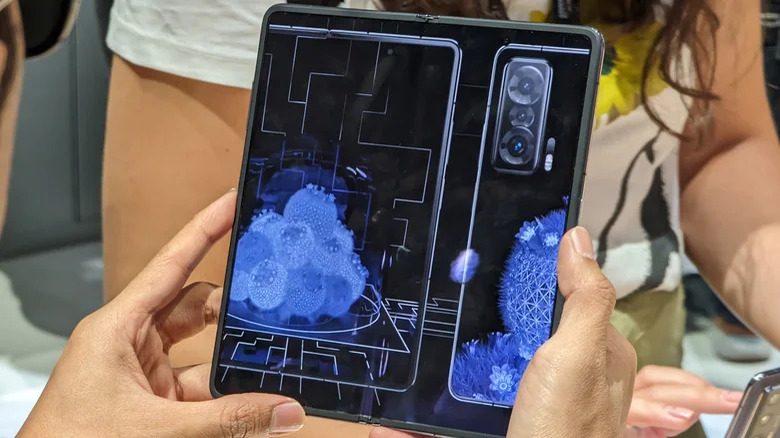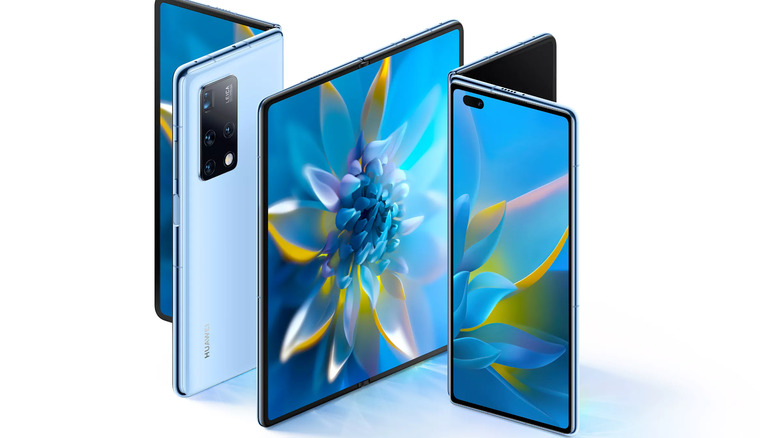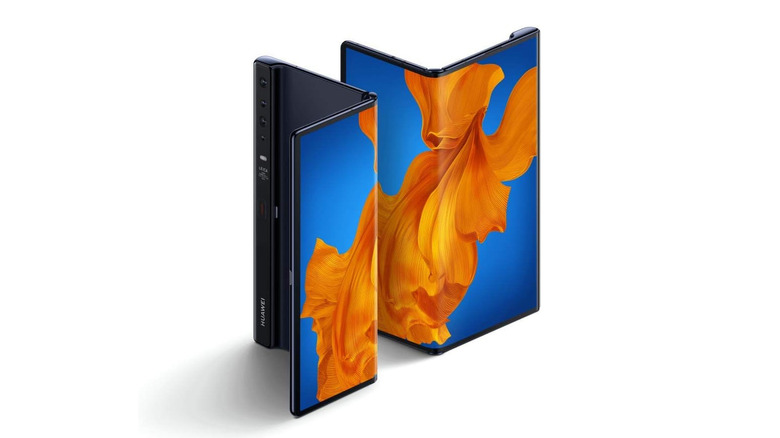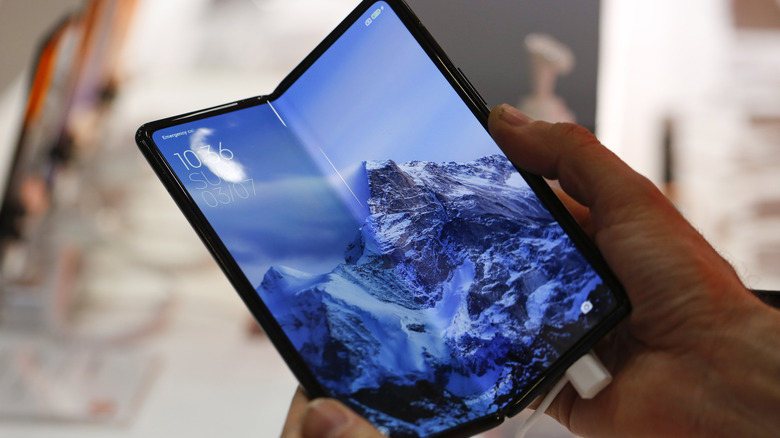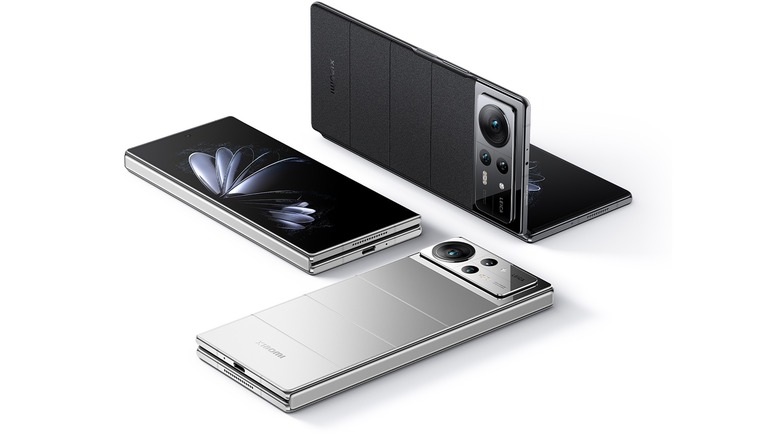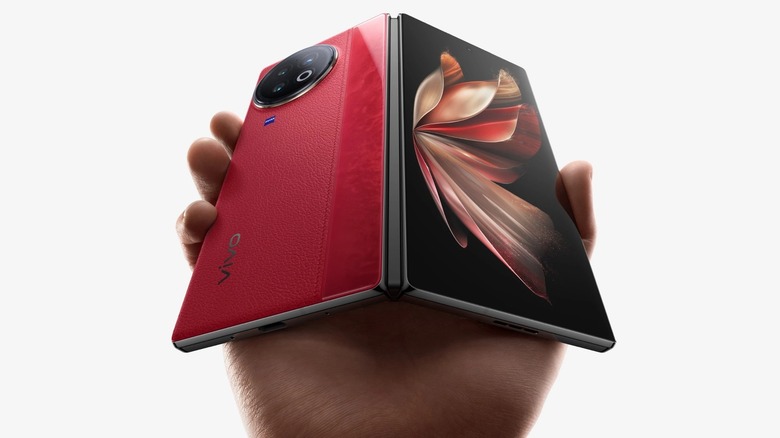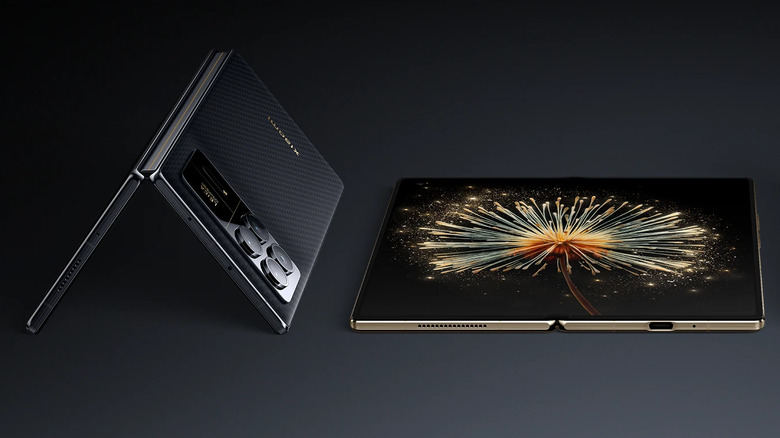From Large To Largest: The World's Biggest Smartphones, Ranked
Since the release of the first iPhone in 2007, smartphones have exploded in popularity and size. It can be confounding to think that the iPhone 5's upgrade to a 4-inch screen was once seen as a groundbreaking improvement, but smartphones used to be pretty pint-sized. It wasn't until the advent of so-called phablets, such as Samsung's original Galaxy Note, that phone sizes really began to inflate.
The first Samsung Galaxy Note boasted a screen size of 5.3 inches, which is almost an entire inch smaller than the 6.1-inch screen of the Samsung Galaxy S23 or the 6.7-inch screen of the iPhone 14. The ever-increasing size of smartphone screens isn't looking to slow down, even with phones like the upcoming iPhone 15 Pro getting smaller without losing any screen real estate.
The only real factor limiting phone growth these days is practicality. After all, a phone can only get so large before it's too large for your hand or your pocket. However, this problem has been effectively bypassed with folding phones, as a phone larger than seven inches can now be folded up for less intensive use.
With folding phones making it simpler to sell a larger phone screen, it's natural to wonder which phone is now the largest. Even though folding phones haven't existed for too long, they still dominate the list of the largest smartphones out there. However, only one phone may reign supreme as the absolute largest smartphone out there.
13. Google Pixel Fold (7.6'' unfolded, 5.8'' folded)
Ranking as the smallest of the smartphone titans is a recent entry into the folding phone fray, the Google Pixel Fold. The Pixel Fold is Google's first attempt at entering the foldable market, and it's perhaps most notable for having a unique form factor from the rest of the field.
Where a majority of the foldables on the market start as more of a candy bar shape before unfolding into a more tablet-like display, the Pixel Fold begins as a more natural-feeling passport shape that unfolds into the same sort of shape as other available foldable phones. However, that unique presence is what explains its spot as the smallest of the largest. While a 7.6-inch display isn't any smaller than certain other foldable phones, the outside 5.8-inch display is considerably smaller than any other foldable's external display, with the exception of the original Samsung Galaxy Fold.
Although the Pixel Fold might not be the largest foldable phone, it is a solid first iteration with lots of room to grow into a second generation. Perhaps the next iteration of the Google Pixel Fold can see this phone move up in the ranks as one of the best — and largest — foldables on the market.
12. Samsung Galaxy Z Fold 5 (7.6'' unfolded, 6.2'' folded)
The Samsung Galaxy Z Fold is perhaps the most well-known phone on the foldable market, with little in the way of a direct competitor for the top of the mountain. In fact, besides the previously mentioned Google Pixel Fold, there is no other tablet-style foldable directly sold in America. However, that doesn't mean that they have the biggest foldable to offer. The Samsung Galaxy Z Fold has had the same sized screen for four generations now, at 7.6 inches when unfolded and 6.2 inches on the exterior display.
The latest iteration of the phone, the Samsung Galaxy Z Fold 5, has left the screen size unchanged from its standard 7.6-inch inner display, with a 6.2-inch outer display that it has had since the Samsung Galaxy Z Fold 2. Over time, the outer screen of the Galaxy Z Fold has made some dimensional changes to get away from the candy bar shape it has, but it has largely remained unchanged.
The only time the dimensions on the device have ever changed was going from the first generation Galaxy Fold to the Galaxy Z Fold 2. The original Samsung Galaxy Z Fold had a 7.3-inch inner display with a much smaller 4.6-inch outer display. With the size of the Galaxy Z Fold having remained unchanged for four iterations of the phone, it remains to be seen if Samsung will change things up too drastically with their next release.
11. Huawei Mate Xs 2 (7.8'' unfolded, 6.5'' folded)
Where Samsung's Galaxy Z Fold lineup has remained largely unchanged in the size department for the majority of its lifetime, the Huawei Mate X lineup is full of changes to the device's screen size. Of the many models of the Huawei Mate X, it is the Huawei Mate Xs 2 that ends up with the smallest screen in this list. The Mate Xs 2 has a 7.8-inch unfolded display with a 6.5-inch display when folded.
What sets Huawei's Mate Xs 2 out from the crowd thus far is that it is the first outie design on this list. While the Google Pixel Fold and Samsung Galaxy Z Fold both have a screen on the outside and a separate, larger screen inside, the Mate Xs 2 has one big screen that folds in half. The benefit of this outie form factor is that it leaves your folded device in a still normal form factor, which is the biggest drawback plaguing Samsung's Galaxy Z Fold innie lineup.
Perhaps the biggest advantage the Huawei Mate Xs 2's outie display holds over the foldless lineup is that it is creaseless, which is an otherwise persistent issue on other foldables that have a clear crease when that's especially noticeable in certain lighting.
10. Huawei Mate X3 and Huawei Mate X5 (7.85'' unfolded, 6.4'' folded)
The Huawei Mate X3 and Huawei Mate X5 are up next with identical form factors. The Mate X3 was released in March 2023 with a 7.85-inch inner display and a 6.4-inch outer display, while the Mate X5 was released later in the year with the same screen dimensions.
Unlike their outie cousin, the Huawei Mate Xs 2, Huawei's Mate X3 and Mate X5 have a form factor more akin to the Google Pixel Fold and Samsung Galaxy Z Fold, with an outer screen and a larger folded display inside. The outer screens are also a more conventional shape than those on the Google Pixel Fold or the Samsung Galaxy Z Fold. Beyond an expansive screen, features such as rapid charging and a great camera make the Mate X3 one of the best foldables available.
If you're left wondering why, despite some of these impressive features, Huawei isn't a more revered name in the foldable market, it's because Huawei phones were banned in America in 2019. Although you can still get your hands on one, this comes with a plethora of issues, such as a lack of Android OS and no access to the Google Play Store.
9. Tecno Phantom V Fold (7.85'' unfolded, 6.42'' folded)
Smartphones are an expensive investment, and it's not all that uncommon to spend nearly $1,000 or more on a flagship phone. Foldable phones can be even worse, with even the smaller clamshell-style phones like the Samsung Galaxy Z Flip or the Motorola Razr steadily hovering at $1,000, while tablet-style foldables often run well above $1,500.
The Tecno Phantom V Fold isn't readily available in America, but converting prices from Amazon India gives it a final cost of roughly $1,070. While its primary screen is the same size as the Huawei Mate X3 and Mate X5's 7.85-inch inner display, the outer screen gets an extra 0.02 inches over the Mate X3 and Mate X5.
The larger display packed onto this affordable foldable makes it a great value for those in the market this phone sells in, as there aren't many other weak points to this phone. While it may not be the largest phone on this list, it is by far the cheapest. Producing a smartphone as affordable as the Tecno Phantom V Fold is definitely worth some credit.
8. Honor Magic V, Honor Magic Vs Ultimate, and Honor Magic Vs (7.9'' unfolded, 6.45'' folded)
Honor's Magic V, Magic Vs, and Magic Vs Ultimate are yet another line of interesting foldable options that aren't available in the United States. All three phones have the same 7.9-inch inner screen and 6.45-inch outer display. The Magic V was released in January of 2022, whereas the Honor Magic Vs and Vs Ultimate served as the next iteration of the phone in December of 2022.
While there wasn't an upgrade to the display between the release of the Magic V and Magic Vs, there were upgrades between devices for the camera and battery. Despite the camera upgrade, it isn't the greatest camera available in the smartphone market. On its face, that isn't too big of an issue. However, the Honor Magic Vs costs roughly $1,700, which is a price tag that should merit a good quality camera.
A final note on the displays of the Honor Magic V and Magic Vs is that the refresh rate for phones' inner display is capped at just 90hz. While not quite as bleak as the base model iPhone's 60hz, it's certainly below what has become the standard. The 90hz cap does, however, preserve battery life on the device. The trade-off for a slightly lower refresh rate is a longer-lasting charge, which the Magic V and Magic Vs do deliver.
7. Honor Magic V2 (7.92'' unfolded, 6.4'' folded)
The Honor Magic V2 offers a number of trade-ups and trade-downs from its predecessors. For starters — and most important to this list — the inner display of the Magic V2 is 7.92 inches, which sits at just 0.02 inches larger than the Magic V or Magic Vs. On the flip side, you lose a small amount of screen real estate on the outer display, which has dropped to 6.4 inches.
The Magic V2 was released in July 2023, and in addition to the small size change on the display, it also received the bump upwards to a 120hz refresh rate for the inner screen. However, while the Magic Vs lower 90hz refresh rate was in place to preserve the phone's 5000mAh battery, the Magic V2 has the exact same battery. Time will tell if Honor's future foldables get a larger display, but for now, the Honor Magic V2 stands as their largest display.
6. Huawei Mate X2 (8.0'' unfolded, 6.45'' folded)
Huawei makes another appearance with the Mate X2. The Huawei Mate X2 is the first foldable on this list with an 8-inch display, though its outer display is tied with the Honor Magic V and Magic Vs at 6.45 inches. Like the previously discussed Honor phones, the Huawei Mate X2's internal display is capped at a 90hz refresh rate.
While it still doesn't have Google Play, the Huawei Mate X2 marks the first Huawei phone on this list to run Android. The Mate X2 sits inside the bubble occupied by its successors, that being an excellent phone that could've been fantastic to have stateside had it not been for the ban on Huawei's products.
However, that's not to say this phone would've been a Galaxy Z Flip killer, as there's one enormous issue that plagues this phone — its price. The retail price of the base Huawei Mate X2, when converted to the American dollar, is roughly $2,800. Paying nearly $2,000 for a foldable isn't beyond the pale, but paying nearly $3,000 for one seems absurd even for enthusiasts.
5. Huawei Mate X and Huawei Mate Xs (8.0'' unfolded, 6.6'' folded)
The Huawei Mate X and the Huawei Mate Xs mark the two largest Huawei phones made up to this point. Both phones sport an 8-inch screen when unfolded and a 6.6-inch screen when folded. This puts both phones in first place for the largest screen when folded. An interesting note on just how large that is — the folded display on either phone is just 0.01 inches smaller than the screen on the iPhone 14 Pro Max.
Despite what the Mate X and Mate Xs naming convention may lead you to believe, both of these phones are outies like the Huawei Mate Xs 2. The Mate X and Mate Xs were released one year apart from one another, and there are really only a couple of hardware differences between both devices, the most important of which is that the Mate Xs packs a more powerful GPU and CPU than the Mate X.
However, the biggest difference between the devices is actually in the software department, with the Mate X having been released at a time when Google Play Services were still available for Huawei. However, neither phone was ever released in the United States, as the Huawei ban went into effect six months before the release of the Mate X.
4. Xiaomi Mi Mix Fold (8.01'' unfolded, 6.52'' folded)
Continuing the trend of Chinese phones that are unavailable in America is the Xiaomi Mi Mix Fold. The Mi Mix Fold's inner display is only one-hundredth of an inch larger than the Huawei Mate X's display, and its outer display sits smaller at 6.52 inches. In another step-down, both displays on the Mi Mix Fold have a 90Hz refresh rate.
At a glance, the Mi Mix Fold looks remarkably similar to the Samsung Galaxy Z Fold, sporting a thinner, candy bar-shaped outer display. However, the Mi Mix Fold packs a few interesting features, such as an impressive 108-megapixel camera that would be dropped from the phone's follow-up models. The Mi Mix Fold's PC Mode was also an impressive first-in-class feature in what seems like a logical step for a foldable device.
One of the biggest advantages Xiaomi's devices hold over Huawei's is that they haven't been banned from working with American companies. Due to this, Google Play Services and Android are both available on the Mi Mix Fold and other Xiaomi devices.
3. Xiaomi Mix Fold 2 (8.02'' unfolded, 6.56'' folded)
The Xiaomi Mix Fold 2 is the follow-up to the Xiaomi Mi Mix Fold and — with a few notable exceptions — it marks an improvement on the original in every way. The Mix Fold 2 has larger screens, with an 8.02-inch display inside and a 6.56-inch display outside, in addition to a better chipset, better refresh rate, and an OLED display. Beyond that, it's also significantly lighter.
The two most notable downgrades going from the Mi Mix Fold to the Mix Fold 2 are the step down from the 108-megapixel camera to a 50-megapixel camera and the move from a 5020mAh battery to a 4500 mAh battery. However, in the scheme of the optimization that the phone received all around, both of these differences left almost no real effect on the device.
Another small improvement the Xiaomi Mix Fold 2 holds over its predecessor is the improved aspect ratio on the outer display, making it feel more like a natural standalone phone screen. Combined with the addition of the higher refresh rate, the Mix Fold 2's outer display became vastly more usable.
2. Vivo X Fold, Vivo X Fold+, and Vivo X Fold2 (8.03'' unfolded, 6.53'' folded)
There are three Vivo X Fold devices, and they all have the same screen sizes. First came the Vivo X Fold in the early months of 2022, followed later in the year by the Vivo X Fold+, and the Vivo X Fold2 joined the fold in 2023. All three devices have a whopping 8.03-inch display inside and a 6.53-inch display on the outside.
Between the three iterations of the Vivo X Fold, there weren't many changes to the display inside or out. Across all three, the displays stayed the same size, with the same resolution and the same 120hz refresh rate. Some of the changes that did occur across the devices were regular improvements to charge speeds, steady upgrades for the chipset, and a steady increase in the abilities of the camera set.
Just like Xiaomi, Huawei, and Honor devices before them, the Vivo X Fold line is manufactured in China and not available for direct purchase within the United States, but the Vivo X Fold does have access to Google Play Services.
1. Xiaomi Mix Fold 3 (8.03'' unfolded, 6.56'' folded)
At last, a titan in the smartphone world has emerged! The race came very close, as both the Xiaomi Mix Fold 3 and the Vivo X Fold have the same sized 8.03-inch inner display. However, the Mix Fold 3 edges out the win by just 0.03 inches, sporting a 6.56-inch display on the outer screen.
Much like its predecessor, the Xiaomi Mix Fold 2, the Mix Fold 3 marks a step up in nearly every department. Aside from the larger size, the inner display didn't receive too major of an upgrade. The cover screen, on the other hand, received a significant improvement in brightness, jumping from 1000 to 2600 nits.
The Mix Fold 3 also received smaller incremental changes you'd expect, such as an increase to a 4800 mAh battery alongside an improved chipset. One major upgrade the Mix Fold 3 received over its previous two iterations is wireless charging capabilities — which is wonderful because it would be quite a shame to see the world's largest smartphone going without that crucial feature.
